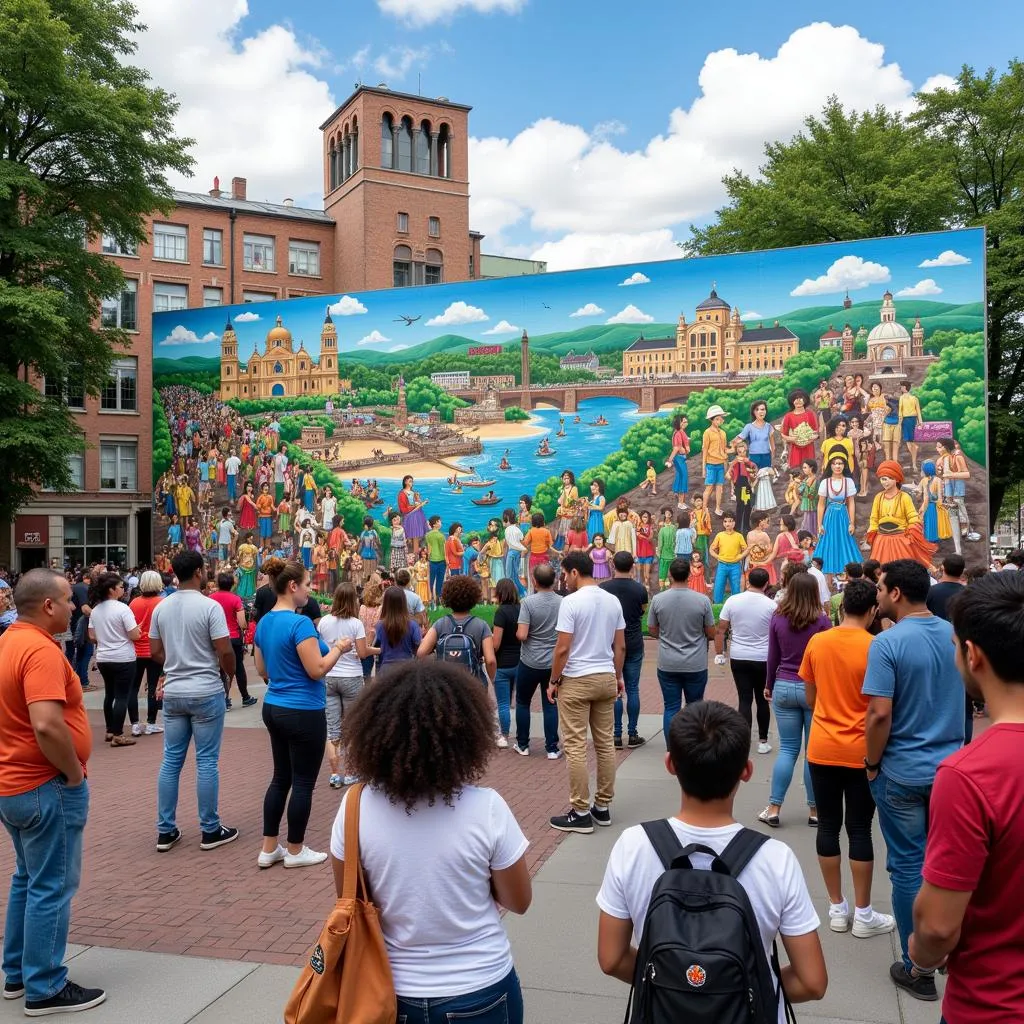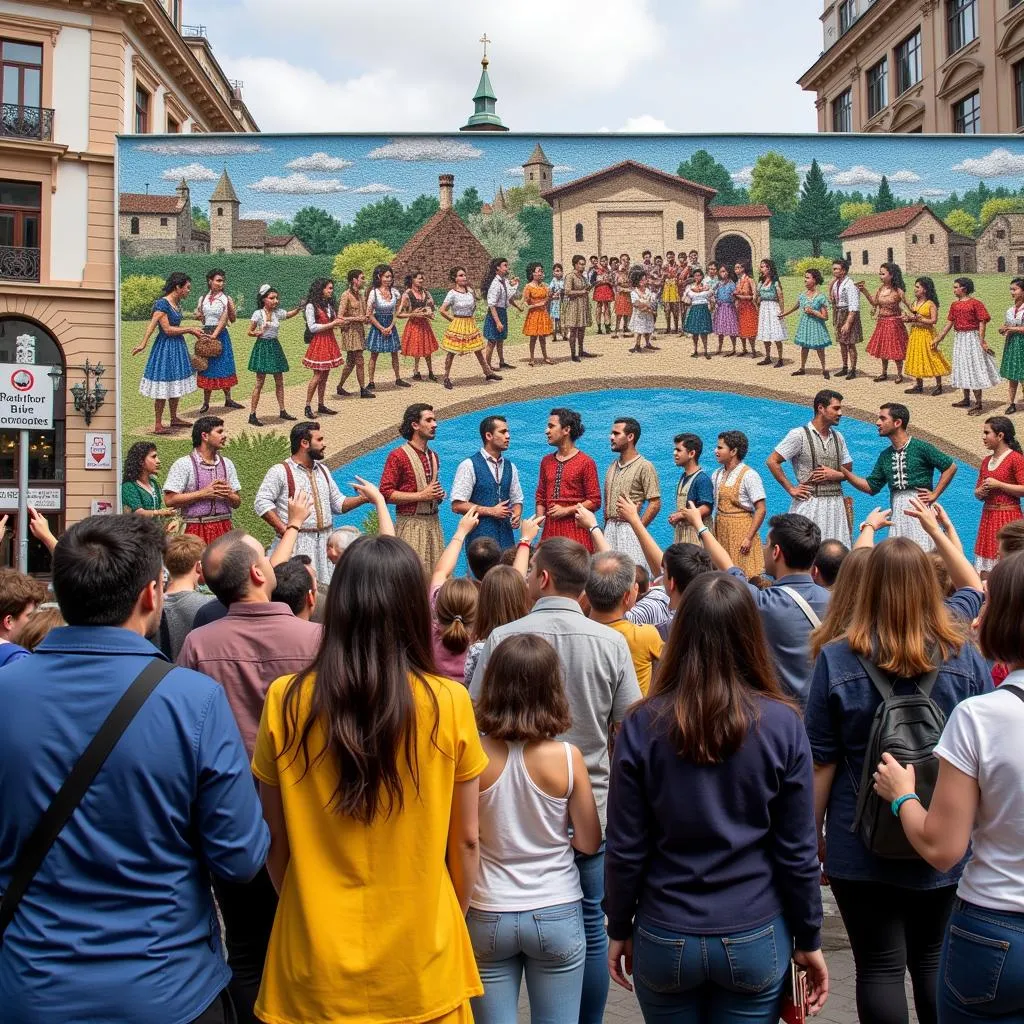Public art plays a crucial role in shaping community identity and has become an increasingly popular topic in IELTS Writing Task 2 exams. Based on recent trends and analysis of past exams, this theme is likely to appear more frequently in future tests. Let’s explore a relevant question that has appeared in recent IELTS exams and provide sample essays to help you prepare effectively.
Some people think that governments should spend money on public art such as paintings and sculptures in public places. To what extent do you agree or disagree?
Analyzing the Question
This question asks for your opinion on government spending on public art. It’s important to note that:
- The question specifically mentions paintings and sculptures in public places.
- You need to state your level of agreement or disagreement.
- You should provide reasons and examples to support your stance.
The importance of public art in urban spaces is a topic that has gained significant attention in recent years. Let’s look at sample essays for different band scores to understand how to approach this question effectively.
Sample Essay 1 (Band 8-9)
Public art, including paintings and sculptures in communal spaces, has long been a subject of debate regarding government expenditure. In my opinion, I strongly agree that governments should allocate funds for such artistic endeavors as they play a crucial role in fostering community identity, enhancing cultural appreciation, and improving the overall quality of urban life.
Firstly, public art serves as a powerful tool for expressing and reinforcing community identity. Sculptures and murals that reflect local history, culture, or values can create a sense of belonging and pride among residents. For instance, the “Cloud Gate” sculpture in Chicago has become an iconic symbol of the city, attracting both locals and tourists while embodying the innovative spirit of the community. Such artworks not only beautify public spaces but also tell the story of the place and its people, strengthening social cohesion and collective memory.
Moreover, government investment in public art can significantly enhance cultural appreciation and education. By placing art in accessible locations, authorities provide free opportunities for citizens to engage with creative expressions, which might otherwise be confined to museums or galleries. This democratization of art exposure can spark interest in cultural activities, stimulate creative thinking, and even inspire future artists. For example, the colorful street art in Melbourne, Australia, has not only transformed alleyways into open-air galleries but also encouraged public discourse about art and its role in society.
 Public art fostering community identity
Public art fostering community identity
Furthermore, investing in public art can have tangible economic benefits for communities. Well-designed and thoughtfully placed artworks can increase tourism, boost local businesses, and even raise property values in surrounding areas. The Angel of the North in Gateshead, UK, is a prime example of how a public sculpture can become a major tourist attraction, contributing significantly to the local economy and putting the region on the cultural map.
However, it is crucial for governments to ensure that public art projects are implemented thoughtfully and inclusively. This involves consulting with local communities, commissioning diverse artists, and balancing artistic merit with public appeal. Additionally, funds allocated to public art should be part of a broader cultural strategy that includes other important aspects of community development.
In conclusion, government spending on public art is a worthwhile investment that yields multifaceted benefits for communities. By fostering a sense of identity, promoting cultural education, and contributing to economic growth, public art plays an integral role in creating vibrant, cohesive, and culturally rich urban environments. As such, it should be considered an essential component of public policy and urban planning.
Essay Analysis
This essay demonstrates several key features that contribute to its high band score:
- Clear position: The writer clearly states their strong agreement with government spending on public art.
- Well-developed arguments: Each paragraph focuses on a specific benefit of public art, supported by relevant examples.
- Cohesive structure: The essay flows logically from one point to the next, using appropriate linking words.
- Sophisticated vocabulary: The writer uses a range of advanced words and phrases accurately.
- Balanced view: The essay acknowledges the need for thoughtful implementation of public art projects.
- Strong conclusion: The conclusion effectively summarizes the main points and restates the writer’s position.
Sample Essay 2 (Band 6-7)
In recent years, there has been a debate about whether governments should use public money to fund art in public places. In my opinion, I agree that some government spending on public art is important, but it should be balanced with other priorities.
One main reason why public art is valuable is that it can make cities more beautiful and interesting. Paintings and sculptures in parks, squares, and streets can transform boring areas into attractive places where people want to spend time. For example, many cities have colorful murals on buildings that brighten up the environment and make people feel happier. This can improve the quality of life for residents and also attract more tourists to visit.
The role of art in representing cultural identity is another important factor to consider. Public artworks often reflect the history and culture of a place, which can help people feel more connected to their community. For instance, a statue of a local hero or a mural showing traditional customs can remind people of their shared heritage and values. This can create a stronger sense of community and pride among residents.
 Public art representing cultural identity
Public art representing cultural identity
However, it’s also important to consider that governments have many other important things to spend money on, such as healthcare, education, and infrastructure. These basic needs should be the top priority. Therefore, I believe that while some money should be spent on public art, it should not be a large part of the budget. Governments need to find a good balance between improving the appearance of public spaces and meeting the essential needs of citizens.
Additionally, when governments do invest in public art, they should make sure it represents the diverse interests and backgrounds of the community. This can be done by involving local people in the decision-making process about what kind of art to create and where to put it. This way, the art will be more meaningful and appreciated by more people.
In conclusion, I agree that governments should spend some money on public art because it can improve the appearance of cities and strengthen community identity. However, this spending should be moderate and balanced with other important needs. By carefully planning and involving the community, governments can ensure that public art brings maximum benefits to society.
Essay Analysis
This essay demonstrates features typical of a Band 6-7 score:
- Clear position: The writer agrees with government spending on public art but emphasizes balance.
- Relevant ideas: The essay presents relevant points about the benefits of public art and the need for balanced spending.
- Examples: Some examples are provided, though they could be more specific or developed.
- Cohesion: The essay has a clear structure with topic sentences and some use of linking words.
- Vocabulary: The writer uses some topic-specific vocabulary, though not as sophisticated as in the Band 8-9 essay.
- Grammar: Sentence structures are generally accurate but less varied than in higher band essays.
- Conclusion: The conclusion summarizes the main points effectively.
Key Vocabulary to Remember
- Foster (verb) /ˈfɒstə(r)/ – to encourage the development of something
- Cohesion (noun) /kəʊˈhiːʒn/ – the act or state of sticking together tightly
- Democratization (noun) /dɪˌmɒkrətaɪˈzeɪʃn/ – the action of making something accessible to everyone
- Tangible (adjective) /ˈtændʒəbl/ – clear and definite; real
- Multifaceted (adjective) /ˌmʌltiˈfæsɪtɪd/ – having many different aspects or features
- Integral (adjective) /ˈɪntɪɡrəl/ – necessary and important as a part of a whole
- Heritage (noun) /ˈherɪtɪdʒ/ – the history, traditions, and qualities that a country or society has had for many years
- Infrastructure (noun) /ˈɪnfrəstrʌktʃə(r)/ – the basic systems and services that a country or organization uses in order to work effectively
In conclusion, the topic of public art and its role in fostering community identity is likely to remain relevant in future IELTS Writing Task 2 exams. To prepare effectively, practice writing essays on related themes such as:
- The impact of public art on tourism and local economies
- The role of community involvement in public art projects
- Balancing traditional and contemporary art in public spaces
- The effectiveness of public art in addressing social issues
Remember to structure your essays clearly, use relevant examples, and demonstrate a range of vocabulary and grammatical structures. Feel free to practice by writing your own essay on this topic and sharing it in the comments section for feedback and discussion.


